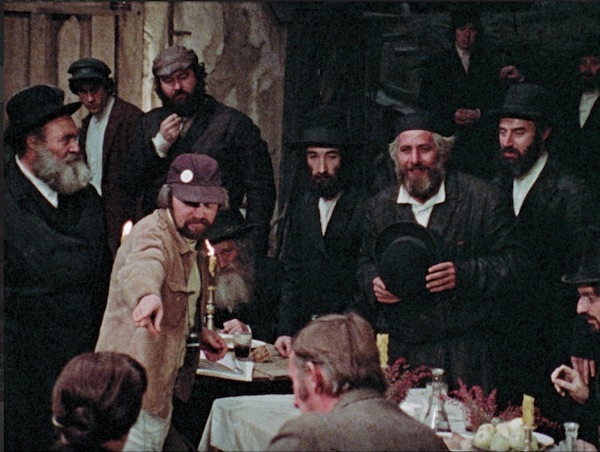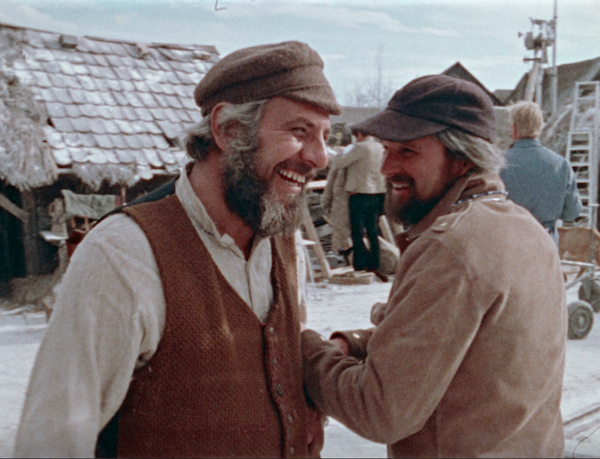Film Review: “Fiddler on the Roof” — The Genesis of a Great Filmed Musical
By Tim Jackson
Daniel Raim’s Fiddler’s Journey to The Big Screen is a terrific documentary about the creation of the titular film.
Fiddler’s Journey to The Big Screen, directed by Daniel Raim. Screening at the Coolidge Corner Theatre

A scene from the film version of Fiddler on the Roof.
The best histories of the creation of individual films consider the genesis of the project as well as the challenges posed to the artists involved. Of course, illuminating political and social context should be supplied as well. The honors list includes Burden of Dreams (Fitzcarraldo), Hearts of Darkness (Apocalypse Now), and the humorous American Movie (which is about two filmmakers making low budget features). Now we have Daniel Raim’s Fiddler’s Journey to The Big Screen, a lively documentary about the creation of the titular film. Photos and footage from the 1971 production are drawn on to tell the story, along with archival images that provide historical context. Norman Jewison, a man Harry Belafonte describes in the film as someone “fiercely committed to social justice” was selected to be the director. Over the course of his career he directed three films that were nominated for Best Picture Oscars. None of them — Fiddler, In the Heat of the Night, or Moonstruck won the trophy. Still Jewison’s films were consistently recognized — over the course of his career they garnered forty Academy Award nominations. In 1999 Jewison received the Irving Thalberg Memorial Award. He danced out onto the stage to the orchestra playing Fiddler’s “If I were a Rich Man.” After receiving a standing ovation he said to the crowd, “Not bad for a goy.”
Growing up in Canada, his school mates assumed from his surname that he was Jewish, though he was not. He had one Jewish best friend and both the boys were picked on. Despite (or because of) the harassment, he found himself attracted to the religion, consideringhimself more Jew than Gentile. When Fiddler came his way he was determined to make it a success — it became a kind of spiritual quest.
Bringing the landmark stage play to the screen required a crack team of collaborators. Recent musicals, such as 1967’s Dr. Dolittle or 1969’s Paint Your Wagon had done badly. As the show’s big-hearted protagonist, Tevye, Zero Mostel had been magnificent in the Broadway production. But Jewison did not want him for the role. The director flew to London to see Chaim Topol, who had performed the lead role in 400 performances. The decision to not choose Mostel was controversial at the time. Jewison explains that Topol “projected a pride in being and a sense of destiny as a Jew. His Tevye never loses dignity and strength.” He thought the flamboyant Mostel was so much “larger than life” that he overwhelm a screen version of the musical.
Working with production designer Robert Boyle, who had designed Mt. Rushmore for Alfred Hitchcock’s North by Northwest, and cinematographer Oswald Morris, who had worked with director John Huston, Jewison sought a location that would infuse a soulful quality into the film. The director wanted three-dimensional set designs, so the camera could move around, be liberated from the limits of the proscenium arch. The former Yugoslavia provided a suitable location, and permission was secured after negotiating with the anti-Stalinist dictator, Tito. The locations, towns Lekenik and Mala Gorica, looked like places time had forgotten.
The filmmakers still needed a wooden temple, but they had all been destroyed during the Second World War. Hollywood crews recreated an entire building in exacting detail. The authentic interiors and costuming were inspired by Roman Vishniac’s celebrated book of photographs which documented pre-war Jewish communities in Central and Eastern Europe. (Janusz Kaminski said that Vishniac was the “guiding force” behind his cinematography for Schindler’s List.) Morris suggested they cover the camera lens with a brown nylon stocking to deepen the earth tones. An assistant was sent out to purchase a slew of large women’s stockings. It worked.

Norman Jewison and Chaim Topol while filming Fiddler on the Roof.
A young John Williams won his first Oscar for scoring and adapting Jerry Bock’s original music. About the revision of the stage music of Fiddler for the film, Bock says: “The adaptation was so right for the film . . . more expansive, obviously, than the theater piece, as was the arrangement, but the arrangement never forfeited the honesty of the original score, or the orchestration. It just embraced [the original], something that only John Williams could do.” (Isaac Stern, one of the world’s greatest violinists at the time, was convinced to contribute fiddle music.) Along with Bock, Boyle, Morris, Williams, and lyricist Sheldon Harnick supply a number of colorful recollections throughout Fiddler’s Journey to The Big Screen. Harnick, now 95, sings a wonderful a cappella rendition of “Sunrise, Sunset” during his interview. (Director Jewison is 95 as well.)
Tevya’s daughters, played by Rosalind Harris (Tzeitel), Michele Marsh (Hodel), and Neva Small (Chava), provide lively anecdotes about auditioning for Jewison and how they found ways to to distinguish each daughter. Topol, with his rich actor’s baritone, recalls the joy of the production, describing how the director told everybody in the cast to look up, lift their heads, elongate the neck, and show pride. “I saw the film in many countries. The issues are universal” says the actor. “The Japanese love the picture because they love the breaking down of traditions.”
Jewison’s Fiddler on the Roof has joined the ranks of 1961’s West Side Story and 1964’s The Sound of Music as one of the great filmed Broadway musicals. At the film’s premiere in Israel, as he was sitting next to Golda Meir, Jewison saw her quickly flick away a tear. “She didn’t want me to see it. But she was crying.” He knew he had discovered important things about himself while making the film. Years later, while shooting Jesus Christ Superstar in Israel, he met David Ben-Gurion. The first Prime Minister of Israel looked at him and said, “What kind of Jew are you?” Jewison responded “What is a Jew?” “He looked at me. Got very quizzical and said, ‘Anybody who is crazy enough to want to be Jewish is Jewish.’ I got that from Ben-Gurion. I accept that.”
Tim Jackson was an assistant professor of Digital Film and Video for 20 years. His music career in Boston began in the 1970s and includes some 20 groups, recordings, national and international tours, and contributions to film soundtracks. He studied theater and English as an undergraduate, and has also worked helter skelter as an actor and member of SAG and AFTRA since the 1980s. He has directed three feature documentaries: Chaos and Order: Making American Theater about the American Repertory Theater; Radical Jesters, which profiles the practices of 11 interventionist artists and agit-prop performance groups; When Things Go Wrong: The Robin Lane Story, and the short film The American Gurner. He is a member of the Boston Society of Film Critics. You can read more of his work on his blog.
Tagged: Chaim Topol, Daniel Raim, Fiddler on the Roof, John Williams, Norman Jewison, Tim Jackson

Great review! I love the 1971 film, a rare movie version of a Broadway musical that creates its own genius. It is very long but so beautifully and artfully made that it is worth the time. Can’t wait to see this documentary.
Thanks, Glen. I’d always wondered why Mostel didn’t get the part. There is much peripheral information around the main story. I found myself going down a Tito rabbit hole into Yugoslavian history. Jewison himself is a great raconteur